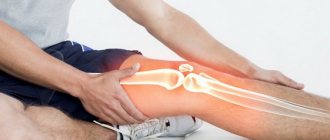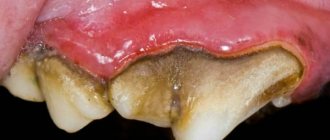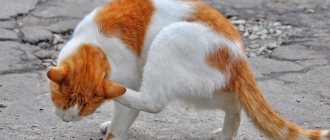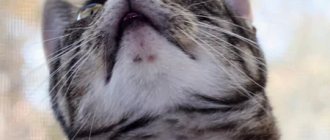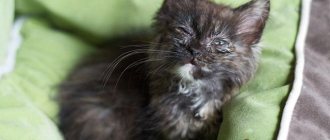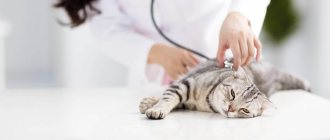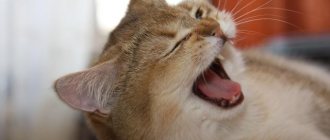Photo: UGC Pets are completely dependent on us, so we are responsible for their health. Ringworm in cats creates a danger not only for the pets themselves, but also for the rest of the household. How many times have we heard our parents’ warnings as children that we shouldn’t touch a barn cat? They scared us of depriving us of other problems. Let's figure out which of this is true and how to help the animal.
How is feline ringworm treated in humans?
If, through carelessness or ignorance, one of the owners became infected with lichen from a cat, then you should not panic, but consult a doctor. In order not to infect others, you must follow all the recommendations received :
- treating affected areas of the skin with a solution of iodine;
- adhere to the prescribed diet;
- taking antifungal and antihistamine medications;
- need to refrain from taking a bath;
- Under no circumstances should you rub the skin with a washcloth;
- carrying out immunotherapy.
It is quite possible to cure feline lichen in humans. For this purpose, the following iodine-containing solutions are used, namely: iodopirone, iodoform, dermicide, antistrumin and others. Treatment of the disease also includes taking one of the antifungal agents: terbinafine, griseofulvin, inraconazole. Of course, the affected areas of hair or skin must be lubricated with ointment: exoderil, lamisil, clotrimazole or ketonazole.
Ointments and shampoos for the treatment of lichen in cats
The most effective products produced in the form of ointments are:
- Clotrimazole - contains the active ingredient of the same name, which effectively helps eliminate ringworm in indoor and outdoor cats. The ointment must be applied to the area damaged by the fungus three times in 24 hours, and the course of treatment is about 30 days. Analogues of the drug - Mikosporin, Clotrisal. The ointment should not be used on pregnant or lactating animals. The drug can also be used in the form of tablets or spray.
- Sanoderm is an ointment containing betamethasone (anti-allergic, anti-inflammatory component), gentamicin sulfate (antibacterial component), nipagin (antiseptic), clotrimazole. The cream is distributed over the affected area twice a day, and after the animal’s condition improves - once a day. The course of treatment does not exceed 4 weeks. If re-treatment is necessary, you must wait 20 days.
- Miconazole is an antifungal agent with the active ingredient miconazole nitrate. To get rid of the fungus, it is enough to lubricate the lichen twice a day. The duration of treatment is from 1 to 2 months.
- YAM is a complex action ointment. The composition of the ointment provides effective control of parasites, while simultaneously providing an antiseptic effect on the infected area. Ringworm must be treated twice a day for 7 - 10 days. The animal's hair is not pre-cut. After completing the treatment course, new hair growth is observed at the site of the lesion. The drug is toxic, so it is not used to treat kittens.
- Griseofulvin is an effective antifungal agent that can be used to treat adult animals and kittens. The ointment is applied for 14 days, 2 times a day. To enhance the therapeutic effect, you can give Griseofulvin to cats in tablet form, adding them to food (0.25 tablets for adult cats and 0.12 tablets for kittens).
The range of effective antimycotics expands the anti-lichen shampoo for cats . The best known is Nizoral (the active ingredient is ketoconazole) and its cheaper analogue is Sebozol. The use of shampoos prevents the spread of lichen throughout the body and is suitable for the treatment and prevention of diseases.
Before treating ringworm in cats , you should consult with your veterinarian, as the instructions included with antifungal medications are often geared toward human awareness. Elimination of deprivation with the indicated doses of drugs can cause poisoning in pets.
Treatment of deprivation
The treatment tactics for lichen are determined by the form and nature of the disease. In many cases, it is enough to put a protective collar on the cat against licking and promptly treat the affected areas of the skin with ointments; in severe cases, therapy should be comprehensive with the use of tablets, injections, and external agents.
It takes 2 weeks for skin wounds to heal, but complete recovery occurs in 4-6 weeks, provided that all the veterinarian’s recommendations are strictly followed.
Tablets, injections, and external remedies help to cope with ringworm. Before treating the sore spot, the hair around it is shaved off for better contact of the medicine with the skin. The list of drugs needed to treat ringworm:
- antifungal sprays (Dermazol, Nizoral);
- ointments (Yam, Lamisil, Miconazole);
- tablets (Terbinafine, Itraconazole, Griseofulvin).
Vaccines are used to treat and prevent disease in cats.
How to suspect lichen
To treat a disease, you need to be sure of the diagnosis. The manifestations of most skin diseases are similar to each other and even a specialist - a veterinary dermatologist - will not be able to determine what exactly the patient is sick with. Therefore, to diagnose skin diseases, various instrumental and laboratory methods are used, which make it possible to distinguish infectious ringworm from harmless allergic dermatitis.
Therefore, within the framework of the article, we can give the only reasonable advice to animal owners who have problems with the skin or coat: visit a veterinary clinic to get a diagnosis. This will save you a lot of nerves and money.
The initial diagnosis of ringworm is done directly in front of the owner using a fluorescent lamp. This is not the most accurate method, and sometimes it does not show the disease. But in some cases, it allows you to determine the diagnosis and begin treatment.
The second quick way is trichoscopy. This method takes 30-60 minutes and can be used virtually in front of the client if the clinic has a minimally equipped laboratory and a veterinarian who can conduct the analysis. Not all veterinarians are proficient in the research technique, and then the sample is sent to a veterinary laboratory. The result will usually come the next day.
There are other methods for diagnosing ringworm. They take longer, but are more accurate, and some can select medications to treat the disease. Such methods are usually used in difficult cases or when the results of trichoscopy are doubtful.
The key to accurate diagnosis of ringworm is proper sampling. Therefore, you should not try to do this yourself: the probability of getting a false negative result is too high simply because the hairs with spores do not get into the laboratory.
Diagnostics
As with other diseases, only a veterinarian can make a diagnosis, confirm or refute your guesses.
The doctor will conduct a comprehensive examination:
- using a Wood's lamp, examine the affected area; the primary method will most likely indicate the presence of lichen - if the diagnosis is confirmed, the fur under the lamp will acquire a green tint;
- examination under a magnifying microscope makes it possible to examine skin scales in detail and see microsporia on the skin or hairs;
- analysis of the scraping for the presence of a nutrient medium - for analysis, a scraping is made from the affected area and sent to the laboratory to identify parasites and fungi.
The first two methods are carried out directly in the doctor’s office, take a few minutes, but do not give a 100% result. The culture is analyzed within 21 days, and its reliability is 100%.
Where does it most often appear?
Usually the disease is localized on the head, ears, muzzle of the animal, on its limbs or tail.
By scratching the infected areas, the cat spreads the infection throughout the body - if treatment is not started in time, the disease will spread over most of the animal's skin.
Perhaps the cat does not have lichen, but baldness.
Diagnosis of the disease
If you have any skin diseases or suspicion of ringworm in your pet cat, you should immediately take your pet to a veterinarian. Only a specialist can diagnose the pathology and prescribe the correct treatment.
What does ringworm look like in cats?
Above the eye
Behind the ear
Photo - what lichen on a cat's back looks like.
In a veterinary clinic, the diagnosis is confirmed using fluorescent (under a lamp), microscopic and cultural (bacterial culture) studies.
Determination of ringworm with a Wood's lamp
Most types of lichen caused by fungus are determined using a Wood's lamp. The spores glow under the lamp with a bright green fluorescent color. The cat is brought into a dark room and ultraviolet light is directed at it.
Before the procedure, you should not treat the affected areas with ointments or powders, as this may complicate the diagnosis. The fact is that some medications also glow green when exposed to ultraviolet light.
You should also know that not all types of fungus can be determined using a Wood's lamp. For some species, you will have to take an analysis and do a culture. This method gives almost 100% results, but takes from several weeks to a month, since the spores grow for a very long time.
Local preparations
Typically, these drugs are applied to the affected areas of the animal. Since they are not safe for internal use, it is necessary to put a wide collar around the cat’s neck to prevent the pet from licking the medicinal product from the body.
Shampoos
Antifungal shampoos are used to treat lichen in cats. Their action alone will not relieve a meowing pet from the disease; it should only be used in a comprehensive manner. It is also not recommended to mix anti-lichen shampoos with regular shampoos.
Nizoral and Sebozol are considered good ones. They contain Ketoconazole, which is excellent against various fungi, infections and bacteria. It is necessary to wash your pet with shampoo 2 times a week for 1.5-2 months.
Ointments, sprays, creams
There are many liquid preparations that help fight lichen in cats, the treatment of which has long been neglected. Before using any ointments, sprays or creams, the animal's skin must first be prepared by cutting short the hair around the lichen spot.
To cure ringworm in a cat, it is recommended to use ointments that contain Clotrimazole. It perfectly helps get rid of fungi, although its use will last at least a month. More advanced products with his participation are Sanoderm and Fungin. Their action heals wounds, relieves inflammation and itching.
The drug Miconazole has a good bactericidal effect. By rubbing it into your pet's skin, it destroys lichen fungi. Yam BC ointment also helps eliminate various dermatological diseases, including ringworm.
But Imaverol can be used to treat lichen in pregnant cats and kittens.
A good option for getting rid of lichen would be sulfur and salicylic ointments.
The affected areas of the skin are lubricated generously with ointment twice a day. The advantage of these drugs is their low cost.
How and with what to treat lichen in a pregnant or lactating cat
Ringworm in pregnant and lactating cats is treated in the same way as in everyone else. They try to give preference to drugs in pharmacological forms for topical application, and pay more attention to protection from licking. It is permissible to use clotrimazole preparations orally. This, of course, is associated with certain risks: determination of embryotoxicity (harm to fetuses) of the drug was carried out on mice and rats and showed that the viability of fetuses decreases in the case of a significant (60 or more times) excess dose of the drug.
But it is unacceptable not to treat ringworm in pregnant and lactating cats, because they can infect both babies and newborn kittens. It will not be possible to protect kittens from licking by the mother and spreading spores, since this is the only way to maintain hygiene in the nest, stimulate independent defecation and many other functions important for newborn kittens.
Symptoms of the disease
Although each species is different, they have both common and individual signs of lichen in cats. General symptoms:
- hair loss in areas where the rash appears;
- inflammation, redness, dryness of the epidermis;
- constant severe itching.
Also, each species has separate, characteristic features.
Symptoms of ringworm
If your pet has contracted ringworm, there are several ways to identify it. Some parts of the fur will quickly fall out, but the rest of the coat will remain unharmed. Before this, the development of a small red rash on the body will begin. Because of them, the cat may itch for a long time. Often he finds no rest or suddenly wakes up from an attack of itching.
More developed lichen in cats can be determined by the following signs:
- the cat develops round spots covered with a crust of flaky skin;
- These areas are not covered with hair, and the hairs nearby thin out and become more brittle;
- if during the scratching process the cat scratches off part of the crust, a red smooth surface will be visible under it;
- over time, the spots increase in size and take on an oval or round shape;
- If the disease is not treated for a long time, hair will no longer grow at the sites of inflammation, as hard scabs will form.
The spots often cause discomfort and itch for animals. Depending on the pathogen, symptoms can affect the pet’s entire body or the head and neck separately. It also happens that some signs of lichen in cats are simply not expressed or are completely absent. This is called the apathetic form of the disease. In this case, only some hairs of the coat are susceptible to loss. Because of this, the disease becomes invisible to the naked eye, which means that the owner may not take any action to treat it for a long time.
Symptoms of pityriasis versicolor
Pityriasis versicolor in cats are pale, oval-shaped spots on the animal’s skin. They quickly spread throughout the body and after a few days occupy most of it. Then the spots begin to grow together, which can cause damage and deformation of the claws. In this case, the cat does not feel itching or any other severe discomfort. The spots may disappear if the surrounding temperature drops.
Symptoms of pityriasis rosea
Sometimes feline pityriasis rosea is confused with an allergy. The fact is that it appears as a small red rash on the skin. In some cases, the spots increase to 2 cm in diameter. A large accumulation of them is usually noticed on the pet’s stomach, in the groin and on the inside of the thigh. Itching is absent or almost not expressed.
The skin on which the spots appear becomes rough. If treatment has not begun for a long time, other microorganisms enter the lesions, which causes much more dangerous consequences, for example, sepsis. In some animals this is accompanied by fever, malaise, joint pain and swollen lymph nodes.
Signs of eczema
Weeping eczema is also characterized by red spots. But in this case, it hurts the pet when anything touches the lesions. The rash is small blisters with fluid inside. Sometimes they open, causing their contents to fall onto the surface of the skin. This is how infection and spread of the disease occurs. And although people should not be afraid of this disease, it sometimes causes febrile conditions in pets.
What does lichen look like in animals?
In domestic dogs, lichen usually appears on the pet's face, belly, and paws. First, single lesions appear, then the infection spreads throughout the skin. The first changes affect the condition of the coat. Hair becomes brittle and falls out. Bald areas are characterized by a rounded shape with fairly clear boundaries.
Over time, the skin begins to peel off, change color, and inflammatory processes are possible. The pet becomes lethargic and passive. Sometimes the temperature may rise.
Symptoms
suspect lichen by how often the cat begins to itch, and the hair in the affected area loses its shine and begins to fall out. These signs accompany all forms of the pathological process, but based on individual symptoms, veterinarians and experienced cat owners can recognize exactly what form of the disease their pet has.
Shearer
The first sign of ringworm is restlessness and constant scratching by the cat in one area. If you part the fur and look closely, you will notice small flaky spots covered with crusts on the skin. The hair above them begins to fall out, and reddish skin is visible in the bald areas. Without treatment for ringworm in cats, the patches become covered with gray scabs and spread throughout the body.
Pityriasis
With pityriasis versicolor, only a small, pale, oval-shaped spot is noticeable on the affected area. After a few days, it increases in size, merges with neighboring ones, forming large lesions. If a cat's paw is infected with lichen, the infection can spread to the claw and cause its deformation. With pityriasis versicolor, the itching practically does not bother the cat; the spots can disappear on their own when the ambient temperature drops.
Pink
Pink ringworm of cats is accompanied by the appearance of pink round spots with a diameter of 1.5-2. Most often they affect the abdomen, groin area, and inner thighs. Itching is very mild or absent. The spots in the center are smooth, but flaky along the edges. Without treatment, they can become infected and lead to fever, joint pain, and inflammation of the lymph nodes.
Weeping
Red spots with small blisters that appear at the initial stage of lichen lichen are very painful when touched. The skin around the spots is hot. The bubbles are filled with liquid, which, when the reservoir ruptures, spills out and infects healthy tissue. A crust forms at the site of the burst bubble.
Your child has microsporia
To children, the world can seem like one big playground full of adventure. But their desire to play in the ground, pet animals, touch other people's things can lead to infection with various infectious and parasitic skin diseases. Children are especially susceptible to this because their immune systems are not yet fully developed. Summer, holidays, children's holidays in camps, outside the city, lead to a seasonal rise in these diseases. Currently, one of the common skin infections is microsporia. Microsporia affects mainly children of preschool and school age, less often adults. Microsporia is caused by a fungus that gets on children's skin called Microsporum. The fungus is very stable in the external environment. In hair, skin flakes, wool, dust, it retains the ability to infect for several years.
How can your child become infected?
Infection occurs through direct contact with a sick animal (cats, kittens, less often dogs), or objects infected with hair or scales (combs, hats). It is possible to transmit microsporia from sick family members, but this happens less frequently. There have been cases of children becoming infected after playing in the sandbox. However, if you follow the rules of personal hygiene, even if the pathogen spores come into contact with the skin, the disease can be avoided.
How does the disease manifest in a child?
After an incubation period of 5-7 days on average, foci of infection appear on smooth skin or scalp. Microsporia can appear on any part of the skin, but more often on exposed parts of the body. In mild forms of the disease, round lesions form on the skin, clearly defined, covered with scaly nodules and blisters along the periphery. They often form bizarre shapes, like a “ring within a ring”. At the same time, vellus hair may be affected, which complicates the treatment of the disease. The number of lesions ranges from single to several dozen. Size from 0.5 to 3 cm. When the scalp is affected, 1-2 large lesions are formed, round in shape, with clear boundaries and abundant pityriasis-like peeling. The hair breaks off at a height of 6-8 mm above the skin level (hence the name of the disease - ringworm), because the hair in the lesion appears to be trimmed. There may be slight itching in the affected area. The general condition of children is usually not disturbed. With a decrease in immunity, a child may experience complicated forms of microsporia - infiltrative and suppurative forms. The infiltrative form is characterized by the development of severe inflammation in the lesion. The suppurative form is characterized by the formation of dense foci, round in shape, consisting of deep abscesses (cavities filled with pus). Nearby lymph nodes increase in size. The child's general condition may worsen and the temperature may rise. If a child has suffered microsporia in a mild form, then no traces of the disease remain on the skin or scalp. After a complicated form of microsporia, scars may remain on the skin, and focal baldness may remain on the scalp.
Before treatment, visit a doctor.
If a suspicious rash appears on a child’s skin or scalp, consult a dermatologist without first lubricating the affected areas, as this may complicate diagnosis. Correct diagnosis is half the success in treatment. Skin lesions with microsporia can be confused with other types of lichen, psoriasis, eczema, and hair loss may not be caused by a fungal infection. The diagnosis of microsporia is established on the basis of external signs and must be confirmed by microscopic examination and isolation of the pathogen (growing on a nutrient medium). An important diagnostic criterion will be the greenish glow of the affected hair in the rays of an ultraviolet quartz lamp. A similar study is also used in veterinary medicine, so if you have any doubts about the health of your furry pet, take him to the doctor too, but to a veterinarian. As in children, ringworm in pets (dogs, cats, etc.) can appear as patches of hair loss and skin inflammation. However, many animals infected with microsporia have no symptoms and appear completely healthy and safe. This phenomenon is called colonization.
How to cure microsporia or ringworm in a child?
If the doctor confirms that your child has microsporia, he will be able to prescribe you the correct treatment, without which the disease can take a very long time to develop, can cause complications and can spread to other people. Uncomplicated, single lesions on the skin, without damage to vellus hair, can be treated on an outpatient basis, using only external antifungal agents. During treatment, you should not bathe your child in the bath; wash only in the shower, trying to avoid areas with rashes and using antifungal shampoo for washing. Be sure to provide your child with individual bath and bedding items, and iron clothes with a hot iron after washing. Disinfect all toys with an available antiseptic or boiling water.
Numerous foci of microsporia on smooth skin, with damage to vellus hair, damage to the scalp, and complicated forms are an indication for treating a child in a hospital. In addition to external therapy, systemic antifungal drugs are used for treatment. The dose and frequency of taking systemic antimycotics is prescribed by the doctor, taking into account the child’s weight, his general condition, and the manifestations of the disease. How do you know if treatment for ringworm is helping?
In order to determine how the treatment is going, it is necessary to take control tests from the lesions for fungi.
If the tests show that there are no living fungi in the scrapings, this will mean that the treatment was effective.
Typically, the number of fungal spores in the skin and hair is significantly reduced 2 weeks after the start of treatment. The complete disappearance of fungi occurs later. Sometimes, despite active treatment, the release of fungal spores can continue for several months.
If tests show that, despite treatment, fungi are still present in the skin tissues, the doctor may advise either prolonging treatment, prescribing you other antifungal medications, or increasing the dosage of the drug.
Is there any other way to quickly cure ringworm?
Unfortunately, there are no faster and easier methods for treating ringworm.
Can ringworm go away without treatment?
There are cases when ringworm went away on its own. However, more often than not, it does not go away without treatment and spreads to other areas of the skin.
In a child with ringworm, if left untreated, the disease may persist into adulthood.
Can ringworm reoccur?
The human body is not able to develop immunity against the fungi that cause ringworm, so both adults and children can develop the disease again if they become infected with the fungi again.
Ringworm can also recur if treatment is not completed and if viable fungal spores remain in the skin tissue and hair.
Is there a (vaccine) shot for ringworm?
Unfortunately, an effective vaccine against ringworm in humans has not yet been developed.
Carefully following your doctor’s recommendations will help you quickly cope with the disease, and following preventive measures will prevent infection.
How to prevent infection with microsporia?
Considering that the main source of microsporia infection are stray animals, parents, and caregivers. teachers should explain to children that they should not pet or play with stray cats and dogs. To prevent microsporia, you must follow the following rules:
Keep children's hands, body, and hair clean. Do not allow children to wear other people's things, hats, or use other people's combs. Make sure that children wash their hands thoroughly after playing outside, after contact with pets, especially if they are walking outside, and do not take them to bed. Under no circumstances should you play with homeless animals. If you decide to bring a cat or dog into your home, you should definitely check them with a veterinarian. Do not throw sick cats and dogs outside. This contributes to the spread of the disease among animals and can become a source of infection for children. Be carefull.
Ointment for ringworm in cats
To treat lichen in cats, complex therapy is used, which necessarily includes ointments. But all appointments must be coordinated with a veterinarian after tests and tests. Some components can only aggravate the situation, and the use of drugs before diagnosis can blur the picture.
Before treatment, the affected areas are washed with a cotton swab or disk soaked in warm water or chlorhexidine. Remove scabs and crusts, and also clean adjacent fur. In some cases, the hair around the spot is cut off. The affected area is dried and only then the ointment is applied, covering healthy areas by 1–2 cm.
Clotrimazole has anti-inflammatory and antifungal effects and is used to treat affected areas of the skin with weeping and ringworm. The ointment is applied in a thin layer to the skin two or three times a day. The course of treatment is at least a week; if necessary, the drug is used for 2–3 weeks. Repeated treatments are recommended after three weeks.
Sulfur ointment is used in the treatment of various forms of lichen. A small amount of ointment is applied to the affected skin, covering 1–2 cm of healthy skin. The course of treatment is from 10 to 20 days.
YAM BK ointment has a pronounced antifungal and antiseptic effect. The drug is applied to the skin in a thin layer (it is not necessary to remove crusts and scabs) 1-2 times a day for a week. In case of relapses, the course of treatment is repeated.
Terbinafine is used to treat fungal skin diseases caused by dermatophytes and lichen versicolor. The ointment is applied to the affected areas 2-3 times a day for 10-14 days. If necessary, the course is repeated after 14 days.
When using any ointments, it is necessary to protect the animal. Cats often lick medications, so you need to use a special collar.
Are traditional methods of treatment allowed?
Considering that a fungal infection causes lichen in cats, treatment cannot be based solely on lotions, rubbing with herbal tinctures and other methods with questionable effectiveness. Folk remedies can be used as an additional measure to enhance the effect of medical therapy.
Your task is to adhere to the prescribed treatment regimen, especially since drugs for external and internal use are inexpensive.
What is lichen?
Ringworm is a fungal disease. That's right, scientifically, it's called dermatophytosis. Affects the skin and its derivatives - hair, claws.
There are three species of dermatophyte fungi that cause skin diseases in pets: Microsporum canis, Microsporum gypseum and Trichophyton mentagrophytes.
Microsporum canis is the most common species in cats and dogs. In the environment, spores of this fungus can live up to 1.5-2 years! Some animals may carry the spores and not show any skin lesions.
Microsporum gypseum lives in soil; Trichophyton mentagrophytes is most often carried by rodents.
Information about the disease
Ringworm in cats is an infectious disease caused by two types of microscopic fungi: Mycrosporum and Trichophyton.
In the first case, the type of lichen is called microsporia, and in the second - trichophytosis. The clinical symptoms of both pathologies are identical.
Microsporia and trichophytosis fungi quickly reproduce by spores, therefore they are very widespread in the environment. These fungal spores can be found anywhere other cats infected with the disease have been.
A decrease in the animal's immunity can cause this disease. To strengthen the animal’s body’s defenses, it is necessary to get vaccinated and know what to feed the cat.
Fungal spores can remain viable in the external environment for up to two years. They are highly resistant to adverse conditions and many disinfectants.
The risk of contracting ringworm for a cat is very high. However, the body of adult and healthy felines has the ability to successfully resist this disease.
Who is at risk
- Kittens up to 1 year.
- Sick animals.
- Cats with weakened immune systems in the postoperative period or after illnesses.
- Free-ranging animals.
You might be interested in:
- scabies in cats.
Prevention
Following these rules will help you avoid getting infected and will save your cat:
- Vaccination of an animal against lichen.
- Never pet other people's cats. Teach your children to do this. Stray street cats are especially dangerous.
- Wash your hands with soap: every time you pet your pet; when you come home from the street; after contact with cat accessories: tray, toys, bed.
- Keep your cat away from dirty outdoor shoes and clothing. Wash your shoes when you get home. Clean your hallway regularly.
- Walk your cat in areas where there are no other animals. Avoid contact with stray animals. It is best to keep your pet in an apartment.
- Isolate a cat infected with shingles from other pets and children for the entire course of treatment.
- At the first indirect signs: restlessness, frequent scratching, take the animal to the veterinarian to make or rule out a diagnosis of ringworm.
Important!
Remember that timely detection of pathology and proper treatment will definitely return your pet to health and will not harm the health of your family!
Vaccination against ringworm
Therapeutic and prophylactic vaccinations against lichen in cats are carried out as part of complex therapy for an animal or for healthy animals as a preventive measure. Vaccinations are given to healthy kittens at the age of 3 months.
Therapeutic vaccination is the most effective modern way to get rid of fungal infections of the skin and fur of cats. Injections are given 2-3 times with an interval of 10-14 days.
Vaccines used in veterinary medicine:
- Polivac TM is a highly effective vaccine based on 8 types of strains of weakened fungi (trichophytin, microsporum). The effect of the vaccine lasts 12-14 months. To develop lasting immunity, a second vaccination is carried out 14 days after the first. Vaccination of healthy cats does not cause complications. After a year, revaccination is carried out.
- Vakderm-F is a drug based on non-living spores of ringworm. The injection therapy product is used simultaneously with topical medications (ointments, sprays). To completely cure an animal, 2-3 injections are enough. For preventive purposes, it is used to vaccinate kittens from 2 months of age and healthy adult animals. The effect of the vaccination occurs after 25-30 days. Vaccination is carried out twice with an interval of 1014 days.
- Microderm is a therapeutic injection veterinary drug with high effectiveness against ringworm. To achieve the result, the medicine is administered to the cat twice with an interval of 10-15 days. The product is characterized by low toxicity. Suitable for preventive immunization.
Important!
Injections against lichen cannot be used in the treatment of pregnant and lactating cats, animals with hyperthermia.
Prevention of lichen in pets
- Get regularly vaccinated against fungus (Vakderm).
- Keep street animals away from your pet.
- Check your pet's skin and coat regularly.
- Treat wounds and scratches with zinc ointment and other antiseptics.
- Maintain good hygiene.
- Treat your pet for fleas and ticks in a timely manner.
- Do not allow your pet to eat from other animals' bowls, especially if they are intended for outdoor dogs and cats.
- Contact your doctor as soon as you notice symptoms of skin diseases - suspicious hair loss, spots.
- Provide your animal with proper nutrition to avoid allergies, weakened immunity, and pathologies associated with metabolic disorders. Do not feed your pet table scraps, do not give fatty, peppery, or other unhealthy foods.
Diagnosis of the disease
Only a veterinarian who will examine the cat and prescribe the necessary treatment can recognize the disease. It is possible to determine ringworm in a cat using one of the methods for diagnosing the disease:
- Isolation of an infectious agent in an environment that promotes its development. This diagnostic method is considered the most accurate. However, the study can take a long time - from 1 to 3 weeks.
A scraping from the surface of the animal's skin is placed in a special composition, where favorable conditions are created for the propagation of the pathogen. First, they simply observe it, and then study the grown microflora under a microscope.
- Examination of hair or skin scrapings under a microscope. This method is not as accurate as the previous one. It is not always possible to see the causative agent of a disease under a microscope. It often happens that this type of test gives a negative result for infected cats.
- Study using a Voodoo fluorescent lamp. This method is considered the least effective, and its results do not guarantee 100% reliability. Areas affected by lichen are highlighted in green. True, some harmless microorganisms glow, but fungi do not always glow in ultraviolet light.
It is important! If lichen is suspected, blood is taken from animals for laboratory testing.
Causes of the disease
The main cause of the disease is infection with fungi, which are the causative agents of lichen. The following reasons contribute to this infection:
- The immunity of a small kitten is not fully formed.
- Too early weaning from the mother's breast. Breast milk contains many antibodies that strengthen the offspring's immunity.
- Malnutrition weakens the body. At the same time, the kitten does not have to be street; the weakest kittens in a large litter can become malnourished.
- Keeping animals in inappropriate conditions. Cold and dampness negatively affect the body's resistance.
- Presence of diseases. A sick kitten is an easy victim of any infection, including lichen.
- Lack of necessary hygiene.
Sometimes the disease occurs in well-fed and well-groomed pets, so it is very difficult to predict its occurrence.
What to do if you suspect lichen in cats
The first thing to do if you suspect lichen in a domestic cat is to isolate the sick animal. There is no need to lock him in a cage or any other tight confined space. A separate room or loggia is suitable if it is warm.
Next, you need to urgently contact a veterinarian for an accurate diagnosis. Its goal is to obtain information about the cause and causative agent of lichen. Based on the research, the doctor will be able to choose the right therapy.
Important: it is strictly forbidden to bathe your pet if you notice signs of lichen. Together with the water, the lichen spores will spread to the entire body, thus increasing the affected area many times over.
During the entire period of diagnosis and treatment of lichen in cats, the following recommendations must be followed:
- use separate dishes for a sick pet;
- if there are other animals in the house, then they need to be isolated, or better yet, removed from the premises for a while to prevent an epidemic;
- Carry out disinfectant cleaning more often, paying special attention to those places where your cat most likes to be;
- wash all bedding and rugs in a disinfectant solution;
- Treat upholstered furniture with a solution of water and vinegar.
The following means are used for disinfection:
- quartz lamp - you need to turn it on in an infected room for 20-25 minutes;
- hot water with the addition of bleach or any other chlorine-containing bleach for washing linen and towels;
- hot steam for processing upholstered furniture;
- water with the addition of bleach, alcohol, iodine, vinegar, soap-soda mixture or 3-4% chlorhexidine for washing surfaces.
Remember that you need to wash not only the floor, but also, if possible, walls, doors, tables, baseboards, paying special attention to corners, crevices and other hard-to-reach places.
Treatment method for ringworm
So, earlier we got acquainted with the symptomatic signs of the main types of lichen. But how, in fact, does the healing process itself take place? Treatment of lichen in cats can be carried out using both traditional and medical technology. As a rule, regardless of the choice of one approach or another, the process of combating a disease requires great effort . So, quite often it takes weeks and even months to completely eradicate the disease. In this regard, some experts propose an alternative way to eliminate the threat - euthanasia. Of course, such an option is considered from a serious point of view extremely rarely. As a rule, only young families resort to it, trying to protect a small child from fungal pathogens. In all other cases, standard drug therapy is used, which involves the use of external and internal agents.
The medical approach shows the greatest effectiveness in the treatment of lichen in cats. The doctor conducting the diagnostic study draws up a wellness plan based on the current picture. The way to fight in this case depends on the severity of the disease. So, we can highlight:
- mild form of lichen - potent vaccine preparations (Vakderm-F, Microderm), as well as ointments and solutions for local use (Fungin, Sanoderm, Epacid-F) are used to eradicate the disease;
- severe form of lichen - the treatment process lasts several months, during which vaccines, oral medications (Itraconazole, Gricin) and emulsion products for bathing the pet (Nizoral, Imaverol, Ketoconazole) are used.
Proponents of the traditional approach to treatment also highlight a number of effective methods of combating fungal pathogens. Among them, the most popular methods are:
- bathing and treating the affected areas with a sulfur solution (1 spoon of lime sulphide per 3 liters of water);
- soaking and removing scaly growths with a soap solution (20 grams of laundry soap per liter of water);
- rubbing ointment from wood ash (the product is made using butter in equal proportions);
- cauterization of foci of infection with iodine solution (individual allergic reactions and intolerances are allowed).
Thus, the process of combating a dermatological disease can be built on the basis of folk or medical principles. The traditional approach to treatment usually requires less investment. However, its effectiveness often leaves much to be desired. The medical approach presupposes the need to attract large financial sums. Fortunately, it also provides the fastest and most reliable results. Finally, it is worth saying a few words about preventive measures aimed largely at reducing the risk of infection for pet owners. So, the infected animal is placed in a separate room or enclosure. All items previously in the cat's possession are carefully processed or destroyed. The surfaces of walls, floors and furniture indoors are disinfected daily. For disinfection and wet cleaning, specialized liquids are used (Laina, Akmadez, Duacid). By carefully following these instructions, the pet owner will significantly speed up the healing process and eliminate the possibility of re-infection.
Symptoms of lichen in cats
The disease ringworm got its name for a reason - animals lose certain areas of their coat, as if they had been cut.
At the initial stage, the pathology manifests itself as a rash on the infected area of the skin. However, under the fur, especially in long-haired breeds, the primary signs may not be noticed.
In this case, careful observation of your pet's behavior will come to the rescue - he may become more anxious. Frequent scratching of certain areas of the skin may indicate that the kitten is infected with lichen.
Video
As the disease progresses, the symptoms of the disease become more pronounced: the animal develops round spots of baldness, and in the central zone of these spots the skin becomes covered with scales and peels off.
Which breeds are more susceptible
Most often, kittens living in groups are affected, for example, in nurseries or shelters; street animals become infected from each other. Pets can also get sick, having become infected, for example, from a mother cat or even from their owners.
Although shingles can affect all breeds equally, it is believed that kittens of long-haired breeds are most susceptible to the disease. This is due to the fact that under long hair the affected areas may be barely noticeable.
Disinfection and prevention
When your pet is completely cured of the skin disease, it is necessary to treat the apartment for cat lichen. Sometimes it is not possible to disinfect an apartment. In such situations, the owners do not know what to do with the cat during treatment.
One option is to place him in a specialized clinic. While your pet is away, you need to thoroughly clean the entire room and wash all surfaces with bleach.
To prevent lichen, you need to get vaccinated in a timely manner, comb your pet's fur more often, bathe it once a week with soap, and not allow it to come into contact with other cats. This way you can significantly reduce the risk of developing lichen.
Your cat's health can be preserved with timely diagnosis and proper treatment. Without proper treatment, skin infections will develop stronger and stronger, which will lead to a worsening of the animal’s general condition.
Causes of lichen
Fungi that cause the development of lichen can be found in grass, soil, or the fur of other animals, and are very viable. Outdoor cats are mostly susceptible to deprivation. However, a domestic cat can be infected by an owner who brought the infection on the surface of his clothing or the soles of his shoes.
The infection is not a serious threat to an adult cat with good immunity. If the animal has experienced great stress, the risk will increase.
Kittens are most susceptible to infection, since their immune system has not yet developed. Animals with other pathologies are also at risk. Poor quality nutrition, wounds and abrasions on the pet’s skin - all this only contributes to lichen infection.
Tags
in cats and in cats and in infected cats and in cats and in cats generalized cats and in cats it is necessary to feed Feeding dogs Feeding cats Feeding rodents Feeding birds Feeding dogs Feeding cats Feeding rodents Feeding birds Feeding dogs Cats treat cats themselves. The type of disease is not dangerous for the disease.
dry stockspeoplecareconditionsproductsvitaminsskiveterinary fleasmore detailsmitebirdstoilet
